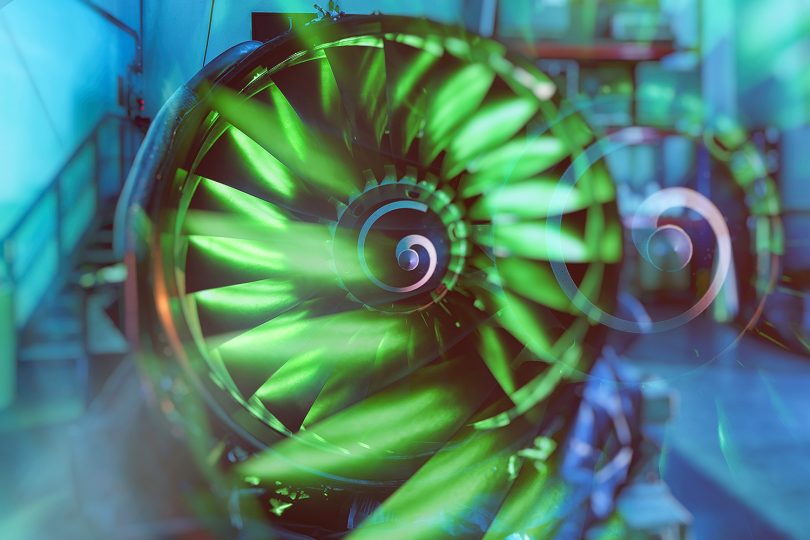New large-scale research device: An eagle for sustainable flying E2AGLE - Laboratory approved for the development of new aircraft electrical systems
In order to make flying more environmentally friendly, electrical systems play a key role. Within the framework of the Cluster of Excellence SE²A “Sustainable and Energy-Efficient Aviation”, new electrical systems are to be developed and investigated, among other things. To ensure that efficiency and the strict requirements for reliability in aviation can be taken into account directly during development, the cluster is now getting a new laboratory, the Electric Aircraft Ground Lab Environment (E2AGLE). The large-scale research device will be set up at two locations, at Technische Universität Braunschweig and at the Leibniz University Hannover, in two subsystems. The German Research Foundation and the state of Lower Saxony will each bear half of the costs, which amount to 3 million euros.
The Cluster of Excellence SE2A is developing electrified drive trains for sustainable and more efficient flying, which have a direct impact on the aircraft design and thus also on the electrical systems structures. With distributed propulsor drives instead of the previous two engines, there are a multitude of new possibilities for designing the drive system, power electronics and electrical system in terms of energy and information flows in combination with modern electric drives.
Centralised and decentralised electrical system topology are investigated
With the help of the large-scale research device E2AGLE, which has now been approved, the topological possibilities of electrical systems and the resulting questions of aircraft propulsion systems can be fundamentally investigated. The large-scale research device will be divided into two subsystems that pursue two development approaches and are technically different: One subsystem investigates a centralised and the other a decentralised electrical system topology, in which free positioning of the storage components in the aircraft is made possible. In terms of information technology, both systems are linked so that the results of the different topologies can be compared.
At TU Braunschweig and Leibniz University Hannover, the two subsystems are being constructed in a modular fashion from individually scalable components – such as replicas of fuel cells or battery storage systems in combination with flight propulsion systems. The cooperative and division of labour approach means that two electrical system topologies can be tested simultaneously for technical performance, reliability and efficiency of flight manoeuvres, failure scenarios, for example the failure of a drive motor, as well as charging procedures.
Comparison of different development approaches in Braunschweig and Hannover
The subsystem of the large-scale research unit to be set up at the Institute for Electrical Machines, Traction and Drives at TU Braunschweig will investigate a central electrical system topology in which all energy sources are connected to a common electrical system. This will enable research work on the flexible design of the energy flows and the associated redundancy and reliability of the system components, despite the high cabling costs. The line losses will be investigated and verified through the use of superconductors in the electrical system.
The part of the large-scale research device located at Leibniz University in Hanover at the Institute for Drive Systems and Power Electronics is researching decentralised electrical system topologies. For this purpose, many small energy storage units are positioned near the drives. In this way, the cabling can be reduced. In return, reliability must be ensured, for example, by increasing the drives.
The results of the investigations of the two development approaches are then compared in order to be able to derive technical recommendations for action.
Voices on the funding
Falko Mohrs, Lower Saxony Minister for Science and Culture “I am extremely pleased that we, as the state of Lower Saxony, can support this important building block within the SE²A cluster of excellence with funding of 1.5 million euros from zukunft.niedersachsen. There is no doubt that E²AGLE will contribute to generating highly relevant and exciting research results for the further development of air transport.”
Professor Angela Ittel, President of TU Braunschweig: “The approval of the large-scale E2AGLE device underlines the outstanding scientific quality of research in the field of our Cluster of Excellence SE2A on sustainable flight at TU Braunschweig and thus contributes perfectly to the further expansion of this cutting-edge research. The approval also confirms the excellence of the applying scientists and their internationally outstanding scientific preliminary work in the Cluster of Excellence. Last but not least, the large-scale device also strengthens our national and international competitiveness and our research focus on mobility enormously. I am particularly pleased that the networking with our important cooperation partner, Leibniz University Hannover, will be further promoted in such a first-class way.
Professor Volker Epping, President of Leibniz University Hannover, adds: “Research into sustainable mobility in all its facets is one of the great challenges facing science against the backdrop of climate change. I am pleased that this urgent question can also be pursued jointly by Leibniz University Hannover and TU Braunschweig thanks to corresponding financial support from politics in the area of the flight cluster.”

